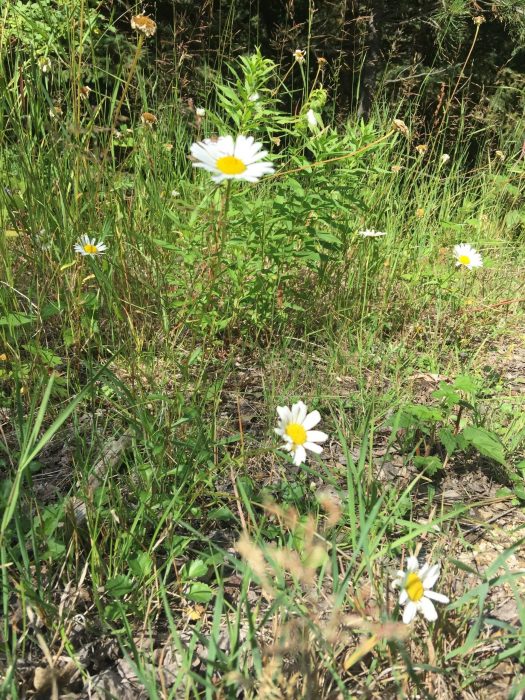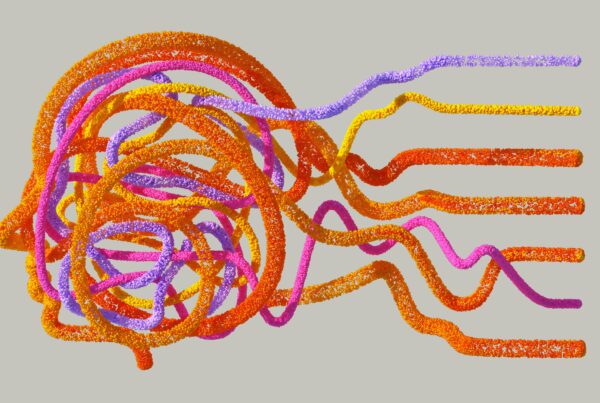by Sara Croymans, MEd, AFC
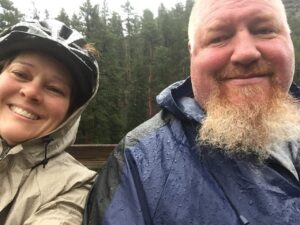 I loved riding bike as a child … feeling the wind blow through my hair, experiencing independence and having the opportunity to interact with my environment in new ways. Last summer my husband, David, and I hauled our bikes (the old fashioned pedal type – not the Harley type) out to western South Dakota for a week long ride on the Mickelson Trail, a rails-to-trails bike path through the heart of the beautiful Black Hills. We planned the trip to have some respite from our careers and enjoy the outdoors. It is important for me to disclose up front that David and I are slightly on the north side of 50 and not super fit. Earlier in the spring we had purchased our bikes and slowly began accumulating miles on the rural roads of the west central Minnesota plains.
I loved riding bike as a child … feeling the wind blow through my hair, experiencing independence and having the opportunity to interact with my environment in new ways. Last summer my husband, David, and I hauled our bikes (the old fashioned pedal type – not the Harley type) out to western South Dakota for a week long ride on the Mickelson Trail, a rails-to-trails bike path through the heart of the beautiful Black Hills. We planned the trip to have some respite from our careers and enjoy the outdoors. It is important for me to disclose up front that David and I are slightly on the north side of 50 and not super fit. Earlier in the spring we had purchased our bikes and slowly began accumulating miles on the rural roads of the west central Minnesota plains.
Now, many months after the trip as the seasons change as I am experiencing the urge to spend time outdoors and have allowed my mind to wander back to that ‘happy’ time and place. My reflections connect how our experience relates to the resilience, mindfulness and community capacity building concepts our OneOp team addresses.
Our family is a military family. David is a Veteran of the South Dakota Army National Guard, serving for 22.5 years with two deployments (Desert Storm and the Iraq War). Our daughter, Kristen, is an officer with the Nebraska Army National Guard and our youngest son, Jesse, and son in law, Jared, both serve in the South Dakota Army National Guard.
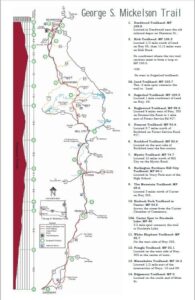 Our plan was to ride 64 of the 109 miles of the Mickelson trail over three days with a day of rest in the middle. We left west central Minnesota on a Saturday with our bikes in the back of the truck for a short four and half hour drive to Pierre, SD. David is from a large family so we were able to spend the night with his sister Susie in South Dakota’s beautiful capital city of Pierre. Sunday we drove the remaining three hours to Deadwood where we would begin the trail. Dave’s youngest sister Paula, her husband Barry and daughter Sophie helped us move our vehicle to Custer where we planned to end the bike ride. Paula had been deployed with Dave in Desert Storm. She joined the Guard while in high school, went to Basic Combat Training and Advanced Individual Training right after high school, arrived home just in time to pass on her Snow Queen crown and was immediately deployed. Barry serves in the SD Army National Guard and works full time for the Guard. Sophie had just arrived back home from participating in a weekend multi-state Regional Military Teen Summit where she was able to network and build relationships with other military-connected teens and gain knowledge and skills to use in South Dakota to support other military youth. Five of the seven siblings in Dave’s family have served in the military. Family is truly an important supportive factor to building resilience and a key part of our supportive community.
Our plan was to ride 64 of the 109 miles of the Mickelson trail over three days with a day of rest in the middle. We left west central Minnesota on a Saturday with our bikes in the back of the truck for a short four and half hour drive to Pierre, SD. David is from a large family so we were able to spend the night with his sister Susie in South Dakota’s beautiful capital city of Pierre. Sunday we drove the remaining three hours to Deadwood where we would begin the trail. Dave’s youngest sister Paula, her husband Barry and daughter Sophie helped us move our vehicle to Custer where we planned to end the bike ride. Paula had been deployed with Dave in Desert Storm. She joined the Guard while in high school, went to Basic Combat Training and Advanced Individual Training right after high school, arrived home just in time to pass on her Snow Queen crown and was immediately deployed. Barry serves in the SD Army National Guard and works full time for the Guard. Sophie had just arrived back home from participating in a weekend multi-state Regional Military Teen Summit where she was able to network and build relationships with other military-connected teens and gain knowledge and skills to use in South Dakota to support other military youth. Five of the seven siblings in Dave’s family have served in the military. Family is truly an important supportive factor to building resilience and a key part of our supportive community.
Monday morning we began the 16.2 mile ride from Deadwood to Dumont where we had a primitive cabin rented. I wasn’t too worried about the ride as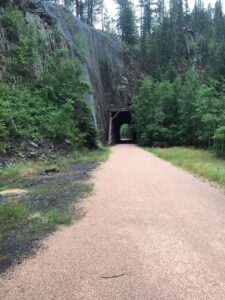 we had been doing 5-7 mile rides in the evenings back home. However, I should have been listening to Dave’s instructions on how to read (& understand!) the Elevation Profile on the trail map. The Mickelson Trail is rated ‘easy to moderate’ with a majority of the trail not exceeding a 4% grade, but parts of the trail are considered ‘strenuous’. We started our trip at the higher end of the trail and travel to the lower end. However, we climbed a bit the first day, and our practice on the occasional rolling hills in west central Minnesota hadn’t prepared us very well. We found ourselves struggling a bit. As with most challenging situations we figured out how to adapt and be resilient. We allowed ourselves to walk our bikes occasionally and we stopped whenever we saw a bench to rest, have a snack and drink water. We also supported and encouraged one another along the way. We successfully arrived at our destination midafternoon, so overall, we did pretty well! We were pleased to see the hot showers and comfortable beds, and were impressed by the hospitality of the owners of Carsten’s Cottages where we stayed, as they had filled our grocery order so we could cook supper that evening! Never underestimate the value of a good plan and a strong support system!
we had been doing 5-7 mile rides in the evenings back home. However, I should have been listening to Dave’s instructions on how to read (& understand!) the Elevation Profile on the trail map. The Mickelson Trail is rated ‘easy to moderate’ with a majority of the trail not exceeding a 4% grade, but parts of the trail are considered ‘strenuous’. We started our trip at the higher end of the trail and travel to the lower end. However, we climbed a bit the first day, and our practice on the occasional rolling hills in west central Minnesota hadn’t prepared us very well. We found ourselves struggling a bit. As with most challenging situations we figured out how to adapt and be resilient. We allowed ourselves to walk our bikes occasionally and we stopped whenever we saw a bench to rest, have a snack and drink water. We also supported and encouraged one another along the way. We successfully arrived at our destination midafternoon, so overall, we did pretty well! We were pleased to see the hot showers and comfortable beds, and were impressed by the hospitality of the owners of Carsten’s Cottages where we stayed, as they had filled our grocery order so we could cook supper that evening! Never underestimate the value of a good plan and a strong support system!
The Mickelson Trail was built on the abandon railroad tracks of the Chicago, Burlington, and Quincy Railroad. The original railroad track, built in 1890-91, 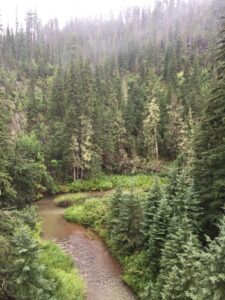 took trains from Edgemont to the northern Black Hills and the gold mines of the Deadwood area. The track was abandoned in 1983 and a group of outdoor enthusiasts recognized the trail’s potential and worked to establish the first ‘rails to trails’ project in South Dakota. Governor Mickelson was a champion of the project and utilized many community capacity building strategies to garner support for the project, including the principles of being good neighbors, good stewardship and creating partnerships for improvement. However, there was controversy about the trail development between local landowners and trail supporters. When Governor Mickelson passed away during the middle of the project many people feared the project was stalled. However, the new Governor, Governor Janklow, supported the momentum of the project and the ten year trail plan was completed in five years. One of the compromises to the controversy was to utilize wood fences as a “buffer” to protect private land owners. The project was extremely successful due to the cooperation of multiple agencies, volunteer groups and individuals. The trail is open four seasons for hiking, biking, equine, snow shoes, dog sleds and a portion for snowmobiles. Annually, over 60,000 people use the trail. The co-creation of the trail by so many is a great example of a successful community capability building effort.
took trains from Edgemont to the northern Black Hills and the gold mines of the Deadwood area. The track was abandoned in 1983 and a group of outdoor enthusiasts recognized the trail’s potential and worked to establish the first ‘rails to trails’ project in South Dakota. Governor Mickelson was a champion of the project and utilized many community capacity building strategies to garner support for the project, including the principles of being good neighbors, good stewardship and creating partnerships for improvement. However, there was controversy about the trail development between local landowners and trail supporters. When Governor Mickelson passed away during the middle of the project many people feared the project was stalled. However, the new Governor, Governor Janklow, supported the momentum of the project and the ten year trail plan was completed in five years. One of the compromises to the controversy was to utilize wood fences as a “buffer” to protect private land owners. The project was extremely successful due to the cooperation of multiple agencies, volunteer groups and individuals. The trail is open four seasons for hiking, biking, equine, snow shoes, dog sleds and a portion for snowmobiles. Annually, over 60,000 people use the trail. The co-creation of the trail by so many is a great example of a successful community capability building effort.
As we reflected on our first day’s ride we were pleased the most difficult stretch of the trail was complete. Forever evaluating and critiquing, I started 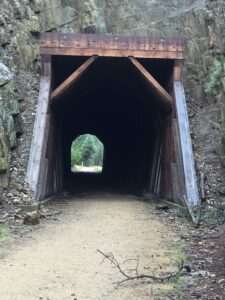 my mental list of what we might do different ‘next time’. We realized quickly that we had over packed our panniers (bike saddle bags). Of course, we needed the water bottles, lights, helmet (I wore one, Dave did not), air pump, tools, spare tire, extra clothes, etc. But we realized we didn’t need as much clothes as anticipated, and we never did use the hammocks that took up precious space. We also reflected on our ‘training’ prior to the trip. Perhaps we should have added some practice on hills to the miles across the prairie.
my mental list of what we might do different ‘next time’. We realized quickly that we had over packed our panniers (bike saddle bags). Of course, we needed the water bottles, lights, helmet (I wore one, Dave did not), air pump, tools, spare tire, extra clothes, etc. But we realized we didn’t need as much clothes as anticipated, and we never did use the hammocks that took up precious space. We also reflected on our ‘training’ prior to the trip. Perhaps we should have added some practice on hills to the miles across the prairie.
On the Tuesday morning, Day 2, Dave made us a delicious breakfast. An important part of my personal resiliency plan is to surround myself with a strong network – one of which is a great cook! Despite the rain, we got an early start. We were thankful that we had packed our rain gear! A significant portion of the 32.5 miles to Hill City was downhill with one section going uphill. Because of the early morning, the light rain, and the secluded trail we saw a lot of wildlife including white tail deer, birds, squirrels, rabbits, buffalo as well as cows and horses. Granite and shale rock formations were an ever constant and it was amazing to see how the vegetation grew in the area. Throughout the week we marveled at the 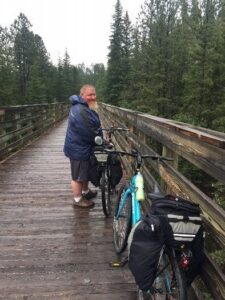 Ponderosa Pine, the Black Hills Spruce (which appeared on the shadow side of the hills), Birch, and Aspen. We also saw daisies growing on the side of the hard trail, trees surprisingly growing out of rock formations, and areas with burnt trees due to wild fires; all evidence of the region’s resiliency.
Ponderosa Pine, the Black Hills Spruce (which appeared on the shadow side of the hills), Birch, and Aspen. We also saw daisies growing on the side of the hard trail, trees surprisingly growing out of rock formations, and areas with burnt trees due to wild fires; all evidence of the region’s resiliency.
The trail has 15 trail heads, 100 converted railroad bridges and 4 rock tunnels. While on the trail, the sounds were amazing. The crushed limestone and granite trail surface contributed to the steady tempo 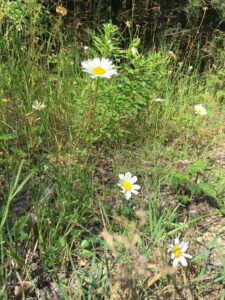 of our wheels. The tempo changed when the trail surface changed, especially when we rode over the wooden bridges. Multiple birds contributed to the sounds, including the occasional screech of a hawk. The soft sound of the rain on the trail and on our rain gear added to the feeling of being in our own little world. The sounds of water running in the creeks, some with rapids, added to the experience. At times, sounds of civilization interrupted the tranquility as we occasionally heard chain saws or traffic on nearby roads.
of our wheels. The tempo changed when the trail surface changed, especially when we rode over the wooden bridges. Multiple birds contributed to the sounds, including the occasional screech of a hawk. The soft sound of the rain on the trail and on our rain gear added to the feeling of being in our own little world. The sounds of water running in the creeks, some with rapids, added to the experience. At times, sounds of civilization interrupted the tranquility as we occasionally heard chain saws or traffic on nearby roads.
While on the trail, it seemed that all of my senses were working overtime. The 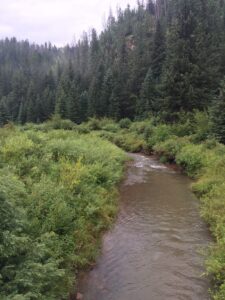 great outdoors offered many scents from nature, including the smell of the rain, cow and horse droppings, and the whiff of smoke from fires at nearby campgrounds. The unique smell of the treated wood on the converted railroad bridges and the decay-type smell from the four tunnels will forever trigger memories of the experience. In addition, the smell of sweat reminded me that hard work was necessary to make progress towards our goals.
great outdoors offered many scents from nature, including the smell of the rain, cow and horse droppings, and the whiff of smoke from fires at nearby campgrounds. The unique smell of the treated wood on the converted railroad bridges and the decay-type smell from the four tunnels will forever trigger memories of the experience. In addition, the smell of sweat reminded me that hard work was necessary to make progress towards our goals.
Prior to the trip I had participated in a six week online “Mindfulness at Work” course through the University of Minnesota Center for Spirituality and Healing. The course explored key mindfulness traits and identified how they relate to essential workplace skills, such as presence, emotional regulation, resilience, cognitive flexibility, and communication, all of which are critical skills for thriving at work. While on the bike trip I found myself applying some of the mindfulness skills to this non-work experience. Merriam-Webster defines mindfulness as “the practice of maintaining a nonjudgmental state of heightened or complete awareness of one’s thoughts, emotions, or experiences on a moment-to-moment basis.” In addition to being aware of the sights, sounds and smells I was experiencing I found myself concentrating on what I was feeling. The rain was wet. The mornings were cold. The afternoon sun was hot. I felt the wind blowing on me. I felt exhilaration when going downhill and felt the burn when I had to pedal uphill. My ears popped with the elevation changes. I had sore muscles. My mind was simply focusing on my surroundings and my interaction with them. I did not think about work or family responsibilities, challenges, joys or worries. I found myself being ‘in the moment’ and concentrating on the trail, what I was doing and where I was going. I found I had to balance my focus on identifying and avoiding obstacles on the trail (rocks, washed out portions of the trail, deer, watching for mountain lions and snakes) with simply being in the experience and enjoying the scenery and our surroundings. (BTW – we were thankful we didn’t see any mountain lions or snakes!)
We felt a major sense of accomplishment as we rode our bikes down into Hill City. We felt much more confident (and proud) about our biking abilities at the end of Day 2 than we had at the end of Day 1. We spent two nights at the historic Alpine Inn, enjoying the beautiful facility and delicious food. It was nice to park our bikes for a full day to allow us to see the local sites – we walked around Hill City, rode an old time steam train to Keystone, and splurged on a helicopter ride around the faces of Mount Rushmore.
Thursday morning we left Hill City and rode 15.1 miles to Custer. This included approximately 8 miles of incline and 7 miles of decline. We were happy we had planned for a day of rest, which allowed us to more successfully navigate the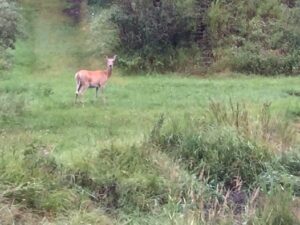 uphill stretch of the trail. We utilized some of the same resilience strategies from Day 1 — allowing ourselves to walk our bikes occasionally, stopping whenever we saw a bench to rest, have a snack and drink water. We admired some really good athletes on the trail and saw others who had to work hard, similar to ourselves. We realized that each person was having their own unique experience, and it wasn’t necessary to compare ourselves to others to measure our success. We arrived in Custer where our vehicle was located in time for lunch. It is amazing how much better food tastes after being in the outdoors (I had the best BLT served with blue cheese spread instead of mayonnaise)! As a treat I was able to secure a massage after lunch (self-care is important) while Dave caught a nap.
uphill stretch of the trail. We utilized some of the same resilience strategies from Day 1 — allowing ourselves to walk our bikes occasionally, stopping whenever we saw a bench to rest, have a snack and drink water. We admired some really good athletes on the trail and saw others who had to work hard, similar to ourselves. We realized that each person was having their own unique experience, and it wasn’t necessary to compare ourselves to others to measure our success. We arrived in Custer where our vehicle was located in time for lunch. It is amazing how much better food tastes after being in the outdoors (I had the best BLT served with blue cheese spread instead of mayonnaise)! As a treat I was able to secure a massage after lunch (self-care is important) while Dave caught a nap.
We didn’t have plans for Friday before we headed home. I felt really good that morning so decided I wanted to attempt to finish the last 45 miles of the trail, which was primarily downhill. Dave agreed to drive the vehicle, connecting with me at three trailheads along the way and then finally picking me up in Edgemont. I was fortunate to meet a young man on the trail from New Jersey who became my riding partner for most of the day. We talked occasionally, but often rode in silence. It was nice to have someone to ride with and share the experience with. I was ecstatic when we arrived in Edgemont and I could say I rode the entire 109 mile trail!!
Our bike trip on the Mickelson Trail was nearly nine months ago, but I continue to reflect on the experience. I think about what is necessary to build my personal resilience and my family’s resilience. I strive to be more mindful of what is happening in the here and now. I intentionally make plans and seek out relationships and build networks to increase our resilience. I admire the capacity of the communities around me to support their members and seek opportunities to contribute to those efforts.
We are making plans for another bike trip this summer …
Please share your stories. How do you build your personal resilience? Do your networks increase your resilience? How have you had success with mindfulness strategies?
This post was written by Sara Croymans, MEd, AFC, University of Minnesota Extension Educator, and member of the OneOp Family Transitions team. Family Transitions provides education, resources and networking opportunities for professionals working with military families to build resilience and navigate life cycle transitions. Engage with the OneOp Family Transitions team on our website, Facebook, and Twitter.

